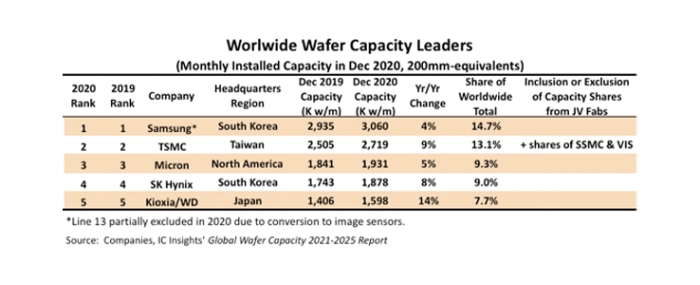
© IC Insights
Analysis |
Top 5 wafer capacity leaders raise their global share to 54%
Each of the top-five wafer capacity leaders had capacity of at least 1.5 million wafer starts per month. The combined capacity of the top five companies represented 54% of total global wafer capacity in December 2020, up one point from 53% in 2019.
For comparison, in the year 2009, the top 10 wafer capacity leaders held 54% of total global capacity and the top five leaders accounted for 36% of capacity. Foundries and memory IC suppliers maintain the strongest capacity presence.
After the top five, wafer capacity at other semiconductor leaders quickly falls off. Intel (884K wafers/month), UMC (772K wafers/month), GlobalFoundries, Texas Instruments, and SMIC rounded out the top 10 capacity leaders.
Samsung had the most installed wafer capacity with 3.1 million 200mm-equivalent wafers per month. That represented 14.7% of the world’s total capacity. Capacity growth in 2020 appears lower than expected because the company’s Line 13 fab was partially excluded from 2020 since a portion of the fab was converted from DRAM to image sensor production in 2020. If all of Line 13 was included in 2020, Samsung’s capacity growth would have been 11%. Much of Samsung’s huge 2020 expenditures will show up in 2021 capacity numbers, especially since $10.5 billion of its total 2020 outlays of $28.1 billion was spent in 4Q20.
Second in line was the largest pure-play foundry in the world TSMC with about 2.7 million wafers per month capacity, or 13.1% of total worldwide capacity. In 2020, the company opened the first two phases of a new fab complex near its Fab 14 site in Tainan, Taiwan. Phases 1 and 2 of Fab 18 are in mass production and the facilities for Phases 3-6 are under construction. TSMC also opened a Phase 10 line at Fab 15 in Taichung, Taiwan, during 2020.
Micron had the third largest amount of capacity at the end of 2020 with a little more than 1.9 million wafers, or 9.3% of worldwide capacity. The company’s capital expenditures in 2020 were mostly for upgrading existing fabs with more advanced equipment, but some new capacity was being added at its fab sites in Hiroshima, Japan, and Taichung, Taiwan. A second fab is being built in Manassas, Virginia, where the company manufactures long-lifecycle products.
The fourth largest capacity holder at the end of 2020 was SK Hynix with nearly 1.9 million in monthly wafer capacity (9.0% of total worldwide capacity), with more than 80% of it being used to make DRAMs and NAND flash chips. The company completed two new large fabs in 2019 in Cheongju, Korea, and Wuxi, China. A new Fab M16 at its site in Icheon, Korea, is due to start mass production in 2021.
Rounding out the top 5 companies was another memory IC supplier Kioxia with 1.6 million wafers/month (7.7% of total worldwide capacity) including a substantial amount of NAND flash memory capacity for its fab investment and technology development partner Western Digital. In 2020, the partners opened a new 300mm wafer fab in Kitakami, Japan. Construction on Fab 7 at the complex in Yokkaichi, Japan, will start in 2021.
The industry’s five biggest pure-play foundries—TSMC, UMC, GlobalFoundries, SMIC, and Powerchip (including Nexchip)—are each ranked within the top 12 capacity leaders. In total, these five foundries had a combined capacity of about 5.1 million wafers per month as of December 2020, representing about 24% of the total fab capacity in the world.
